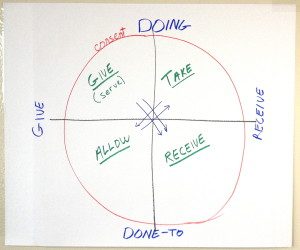This week I took part in a couple significant learning experiences. Amory Ballantine, the grants coordinator at GRuB, spoke with the interns about the basics of choosing and writing grants for a non profit organization. We learned about strong and effective strategies with the distribution of income from multiple sources. GRuB aims to attain about 20% of their income from grants and the rest is donation based from community fundraising. This is because community fundraising has the tendency to be a more consistent and reliable source of income. There is also a term known as “mission drift” which happens when a company is relying too heavily on grants for funding. It can result in moving away from a company’s original mission, and the needs of the community, toward the grant requirements.
Some factors to consider when choosing a grant are that they usually take 6 to 8 months to receive the money after applying, that new projects are more difficult to get grant funding for, and when applying for a grant one must have a very detailed plan or map of how the money will be used. Other things to keep in mind are: How much money do you need? Why do you need it? How is it connected to your and the funder’s mission? It is also a good practice to read the funder’s mission and get a sense of their public presence. In terms of ethical mindfulness, another way to choose grants is noticing what sources of proof they are asking for. If they are asking for personal information about clients, it may not be a great idea to apply for that grant. GRuB makes this one of their top priorities because they don’t want to jeopardize their clients’ vulnerability with releasing personal information. I thought it was all very interesting information and noticed that a lot of factors that are put into writing a grant are quite similar to writing an ILC. The writer has to have a very thought out plan of what their projects will involve, how they plan to complete these projects, and background knowledge on the chosen topic being written about. Some funders for GRuB include the USDA program, the Rural Cooperative Development Grant Program, the Community Investment Partnership, and In Kind Donations.
On Wednesday evening our group at The Red Thread Apothecary got to participate in a workshop run by a woman named Trudis who does consent work with the transgender community in the Olympia area. Our workshop involved learning about the sensations of touch, the meaning of consent, and practicing consensual non-sexual touching with each other. This was all to be tied in with the idea of understanding somatics, and how to listen to different sensations in our body when asking, or being asked, questions around personal boundaries. One of Trudis’ concepts consisted of 2 ideas for enjoying being touched and touching others. They are knowing that you have a choice to be touched or not, and knowing it’s okay to have curiosity or desire to touch others with permission. She also introduced us to the wheel of consent which was created by a chiropractor, bodyworker, and intimacy coach named Betty Martin. This is a basic outline of what it looks like. 
There is the DOING portion which is the person who is doing the touching and that involves giving or serving and taking. The DONE-TO portion is the person being touched and it includes allowing or surrendering, and receiving or accepting. The left two quadrants are giving actions for the other person and the right two quadrants are receiving actions that are meant for the person experiencing them. The red circle is the line of consent. When any of these actions reach outside this line they include experiences such as assault, resentfulness and entitlement. When people are able to experience these different actions within the line of consent then they are able to feel things such as generosity, integrity, openness, and connection.
We ended the lecture with seeing how we could relate all this knowledge to our wildcrafting practices and learning how to ask for consent from nature when harvesting plants for medicine making. I learned a lot about my own personal boundaries with others. It was also such a privilege to have a safe space in which we could practice saying and hearing no and opening up to one another’s touch.
The rest of the week was super busy out at GRuB. Since the weather was warm and sunny we were able to finish applying all the soil amendments out in the fields along with shaping most of the raised beds for the growing season. I was also asked to help facilitate a field trip in which I led a small group of 5th graders around the farm to different farm related workshops that were taught by the youth. It was really impressive to see the youth speak to the 5th graders and take on a role of leadership. Overall it was a busy week and soon we will be planting things from the greenhouse out into the fields.

Be First to Comment